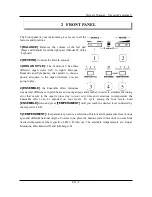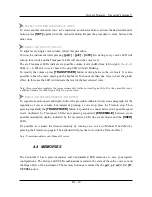
Owner's Manual – Viscount Cantorum V
data is sent back to the instrument, it automatically repeats the recorded performance.
MIDI is able to transmit a multitude of digital data by means of just one cable, and thus just one connector. This is
thanks to the MIDI channels. There are 16 MIDI channels, and in a similar way as for radio communications in which
two stations can only communicate if they are tuned to the same frequency (or channel), two MIDI instruments
connected together are only able to communicate if the transmitter instrument channel is the same as the receiver
instrument channel.
MIDI messages subdivide into channel messages and system messages. The following is a short description of these
messages:
CHANNEL MESSAGES
NOTE ON
This message is transmitted when a note is pressed on the keyboard. Each Note On message contains the following
information:
Note On
: when a key has been struck;
Note Number
: the key which has been pressed, and therefore the relative note played;
Velocity
: note dynamic (i.e. the force applied when the key was struck).
Note messages are expressed as a number from 0 to 127, with middle C represented by number 60.
NOTE OFF
This message is transmitted when a key struck previously is released.
When it is received, the sound of the note relating to the key is switched off. Each Note On message contains the
following information:
Note Off
: a key has been released;
Note Number
: which key has been released;
Velocity
: dynamic (i.e. how fast the note was released).
N.B.:
A Note On message with Velocity=0 is considered equivalent to a Note Off message.
PROGRAM CHANGE
This message is used to select the programs or sounds of the receiver instrument.
There is also a specific standard called General MIDI which describes which sound should be recalled for each Program
Change received. This association is usually described by means of a table included in the user manual of the
instrument which adopts the standard.
This message contains the following information:
Program Change
: voice or program change;
Program Change Number
: the number of the program or voice to be activated;
CONTROL CHANGE
These are control messages (often associated to trimmers or pedals) used to add expression to the performance,
allowing you to set (and control in real time if necessary) voice parameters such as volume (CC n.7) or the position of
the expression pedals (CC n.11), etc.
This message contains the following information:
Control Change:
a controller has been adjusted
Controller Number:
which controller has been adjusted
Controller Position:
the position of the controller
SYSTEM MESSAGES
SYSTEM EXCLUSIVE
These messages can only be interpreted by an instrument made by the same producer as the transmitter device (in some
cases only by the same model). They mainly relate to the instrument’s sound generation and programming parameters.
The Cantorum V uses these messages to control all the internal parameters and for switching the voices on and off.
EN - 12















































